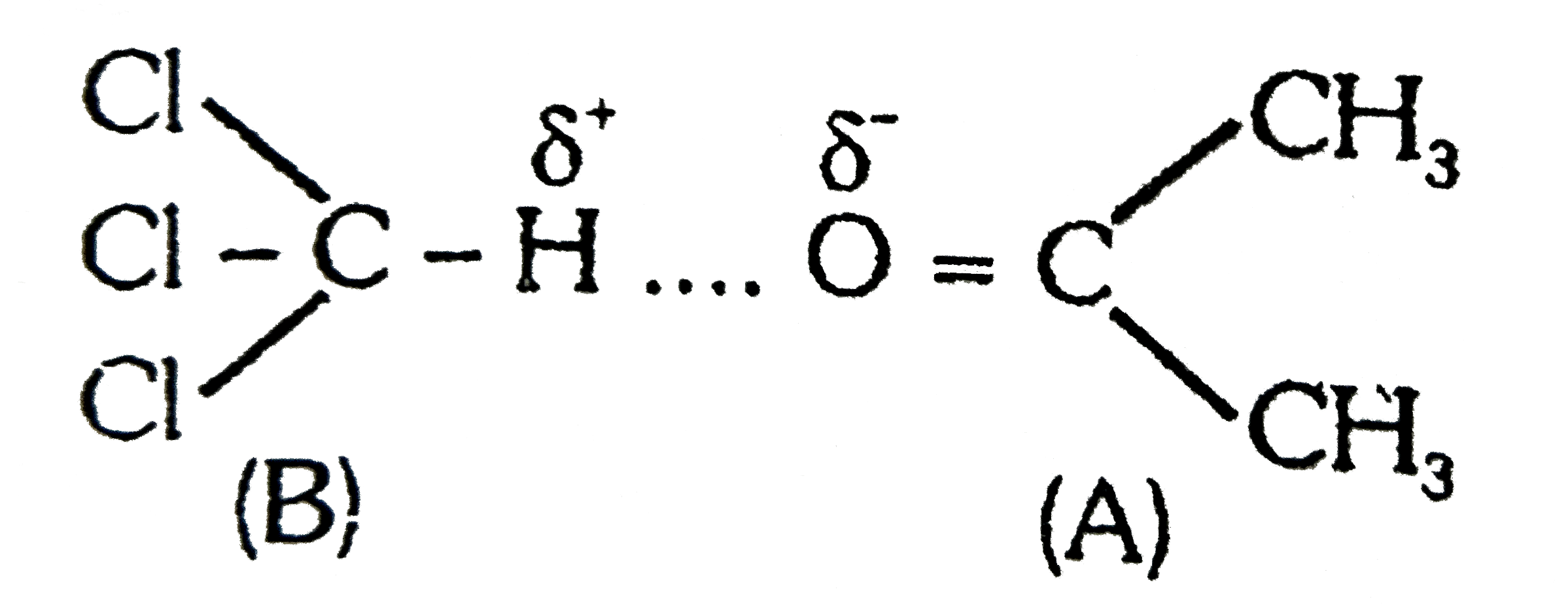Column−IColumn−II(a)Acetone+CHCI3(p)ΔS>0(b)Ethanol +water(q)ΔH>0(c)C2H5Br+C2H5I(r)ΔH<0(d)Acetone+Benzne(s)Maximum boiling azetropes(t)Minimum boiling azeotropes
The correct Answer is:(a)→p,r,s;(b)→p,q,t;(c)→p;(d)→p,q,t

On mixing entropy (disroder) always increase (P) FA−A&FB−B= Dipole - Dipole <FA−B [H-Bond]
∴ Negative deviation from ideal solution
ΔHmiax<0(r)
Those solutions which exihibt negative deviation form maximum boiling axeotrope(s)
Topper's Solved these Questions
- SOLUTIONSBOOK - ALLENCHAPTER - SOLUTIONSEXERCISE - EXERCISE-04 [A]
17 Videos
- SOLUTIONSBOOK - ALLENCHAPTER - SOLUTIONSEXERCISE - EXERCISE-04 [B]
20 Videos
- SOLUTIONSBOOK - ALLENCHAPTER - SOLUTIONSEXERCISE - EXERCISE -02
44 Videos
- S-BLOCK ELEMENTS BOOK - ALLENCHAPTER - S-BLOCK ELEMENTS EXERCISE - EXERCISE -3
1 Videos
- Some Basic Concepts of Chemistry (Mole concept)BOOK - ALLENCHAPTER - Some Basic Concepts of Chemistry (Mole concept)EXERCISE - All Questions
39 Videos
Similar Questions
Column-IColumn-II(A)Acetone +CHCl3(p)ΔSmix>0(B)Ethanol + Water (q)ΔVmix>0(C)C2H5Br+C2H5I(r)ΔHmix<0(D)Aceton + Benzene(s)Maximum boiling azeotropes(t)Minimum boiling azeotropes
View SolutionColumn-IColumn-II(A)Acetone +CHCl3(p)ΔSmix>0(B)Ethanol + Water (q)ΔVmix>0(C)C2H5Br+C2H5I(r)ΔHmix<0(D)Aceton + Benzene(s)Maximum boiling azeotropes(t)Minimum boiling azeotropes
View Solution[B] Match the solutions in Column-I with their nature in Column-II :
Column-IColumn-II(a)Benzene + toluene(p)Non-ideal solution(b)Ethanol + water(q)Ideal solution(c)Benzene + chloroform(r)ΔHmix>0(d)Carbon tetrachloride + chloroform(s)ΔHmixing=0
View Solution[C] Match the solutions in Column-I with their nature in Column-II :
Column-IColumn-II(a)n-hexane + n heptane(p)Can be perfectly separated by distillation(b)Acetone + chloroform(q)Maximum boiling azeotrope(c)Acetone + aniline(r)Cannot be perfectly separated by distillation(d)Ethanol + water(s)Nearly ideal
View SolutionColumn-IColumn-II(A)NH3p linear(B)BeF2q polar(C)H2Orμ=0D(D)CO2s Angular
View SolutionWhy ethanol has higher boiling point than C2H5Br?
View SolutionMatch the column :
Column-IColumn-II(A)ΔH=qp(p)ΔH∘f=0(B)Kirchhoff's equation(q)A definite quantity(C)H+(aq)(r)ΔH2−ΔH1=ΔCP(T2−T1)(D)Spontaneous process(s)ΔG>0(t)ΔS∘Total>0
View SolutionFigure below shows different processes for given amount of ideal gas

Column IColumn II(A)In figure (i)(P)ΔQ>0(B)In figure (ii)(Q)ΔW<0(C)In figure (iii)(R)ΔQ<0(D)In figure (iv)(S)ΔW>0(T)dU=0
View SolutionMatch the following :
Column IColumn II(a)Denatured spirit contains(p)CH3OH(b)Absolute alcohol contains(q)C2H5OH(c)Rectified spirit contains(r)Petrol(d)Power alcohol contains(s)4.5%water
View SolutionColumn-IColumn-II(a)C(s,graphite)+02(g)→CO2(g)(p)ΔH∘_(Combustion)(b)C(s,graphite)→C(g)(q)ΔH∘_(combustion)(c)CO(g)+12O2(g)→CO2(g)(r)ΔH∘_(atomization)(d)CH4(g)→C(g)+4H(g)(s)ΔH∘(sublimation)
View Solution
